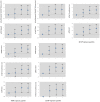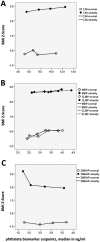Age and sex-specific relationships between phthalate exposures and obesity in Chinese children at puberty
- PMID: 25121758
- PMCID: PMC4133266
- DOI: 10.1371/journal.pone.0104852
Age and sex-specific relationships between phthalate exposures and obesity in Chinese children at puberty
Abstract
Objective: To examine the age and sex-specific associations of urine levels of six mono-phthalates with body size and fat distribution in Chinese children at puberty.
Materials and methods: Four hundred and ninety-three school-aged children (247 boys, 246 girls) were recruited. Obesity related anthropometric indices were measured and body fat proportion (BF%) was calculated. Spot urine samples were collected and phthalate monoesters were detected by an API 2000 electrospray triple quadrupole mass spectrometer (ESI-MS/MS). Associations between phthalate exposure and overweight/obesity measures and their trends were examined by multiple linear regression and Logistic regression analyses, respectively.
Results: Di-2-ethylhexyl phthalate (DEHP) metabolites and monobutyl phthalate (MBP) were found to be the most detectable chemicals. In 8-10 years (yrs) group, concentrations of MEHP and MBP were significantly higher in girls than those in boys. However, concentrations of all phthalate monoesters, except for MEP and MEHP, in 11-13 yrs boys were significantly higher than those in girls. After adjusting for confounders including puberty onset, urinary concentrations of MBP and sum of low molecular-weight phthalate metabolites (∑LMP) were positively associated with boys' obesity in a concentration-effect manner, while concentrations of MEHP, MEHHP and sum of DEHP metabolites (∑MEHP) were negatively associated with girls' obesity. Associations between phthalate exposure levels and BMI z-score changes were age- and sex-specific in school-age children.
Conclusion: There are age and sex-specific concentration-effect associations between phthalate exposure and fat distribution in Chinese children. Urinary phthalate levels in 11-13 yrs boys were about 30 percent higher than those in girls, and ∑MEHP levels in younger boys (<10 yrs) were significantly higher than those in elder boys (>10 yrs). Associations were positive for MBP and ∑LMP with both BMI z-score and fat distribution in boys >10 years of age, and negative for ∑MEHP with fat distribution in girls <10 years of age.
Conflict of interest statement
Figures



References
-
- World Health Organisation (2009) Global Health Risks: mortality and burden of disease attributable to selected major risks. http://www.who.int/healthinfo/global_burden_disease/global_health_risks/en/index.htm
-
- de Onis M, Blössner M, Borghi E (2010) Global prevalence and trends of overweight and obesity among preschool children. Am J Clin Nutr 92: 1257–1264. - PubMed
-
- Wang J, Mei H, Chen W, Jiang Y, Sun W, et al. (2012) Study of eight GWAS-identified common variants for association with obesity-related indices in Chinese children at puberty. Int J Obes (Lond) 36(4): 542–547. - PubMed
-
- Guh DP, Zhang W, Bansback N, Amarsi Z, Birmingham CL, et al. (2009) The incidence of co-morbidities related to obesity and overweight: a systematic review and meta-analysis. BMC Public Health 9: 88 doi:10.1186/1471-2458-9-88 - DOI - PMC - PubMed
Publication types
MeSH terms
Substances
LinkOut - more resources
Full Text Sources
Other Literature Sources
Medical
Miscellaneous

